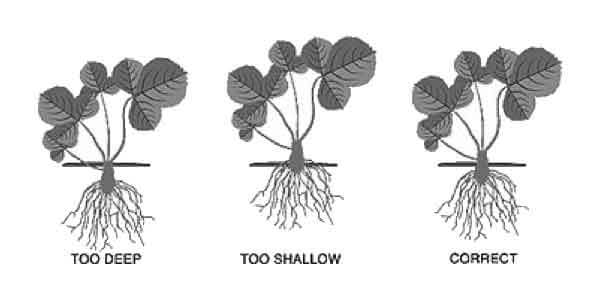How to grow strawberries –

PLANTING STAWBERRIES AND KEEPING THEM HAPPY!
Although strawberries can be grown from seed we recommend growing from bare root for the best success. Prebook your strawberry roots from Cedarcrest Gardens from January to April to arrive just in time for planting.
SITE SELECTION AND PREPARATION
Strawberries require full sun for optimum fruit production. Plants which receive a minimum of six hours of direct sunlight each day should grow well and produce a harvestable crop, but berries will be fewer and fruit quality reduced compared to plants receiving more sun. Eight or more hours of sunlight each day is ideal.
Choose a site located away from trees and buildings which will cast shade for more than a few hours each day. Because trees will compete for water and nutrients as well as cast shade, the strawberry bed should lay beyond the root zone of large trees. The root zone roughly corresponds to the canopy of a tree.
Soil should be both water-retentive and well-drained as strawberry plants will tolerate neither drought, nor standing water. Excessively drained soils should be amended with peat or compost to improve water retention, while heavy clay soils will benefit from the addition of a mixture of peat and a coarsely textured organic material, such as chopped leaves or straw, to improve drainage and aeration.
Strawberry plants perform best in slightly acid soil, a pH of 5.3 to 6.5 is optimum, but readings from 5.0 to 7.0 are acceptable. Conduct a soil test to determine any necessary pH adjustment, as well as fertilizer needs. For professional soil testing, please contact your local Agricultural Office.
The site selected should be free from weeds, grubs and soil-borne diseases.
PLANTING
Plant in spring as soon as the soil can be worked. When you purchase your planting stock from our nursery, plant as soon as possible after receiving them. Dormant plants may be stored in a cool place for several days, if immediate planting is not possible. Do not store plants close to ripening fruits as they could be damaged by gases given off during the ripening process. Do not allow the packing material surrounding the roots to dry out or become soggy. A cool, cloudy planting day will place the least stress on new transplants.
At planting time, damaged roots should be trimmed and excessively long roots cut to 4 – 5 inches (10 – 12 cm) in length. In addition, all flowers, runners and old leaves should be removed. Keep the plants protected from direct sunlight and drying winds during planting.
Strawberry plants should always be set with the roots pointed downward and forming a moderate fan. Planting depth is critical. If the plants are set too shallow, the crown may dry out, while a too-deep position may result in crown damage or rot. Set the plants deep enough so the midpoint of the crown is even with the soil surface. After setting in, firm the soil around the plant and thoroughly water. Set plants deep enough so all of the roots are covered but the crown is above the soil line. (see below) The plant on the left is too deep and the one in the center is set too shallow. The roots should extend straight downward.

SPACING
Plants are normally grown in rows spaced approximately 38” apart and planted with 12” spacing between
TYPES OF BERRIES
June-Bearing
This is the most common grown type. Buds form in the fall then bloom the following spring, producing one large harvest, typically in June. Blossoms need to be removed in the first year of planting so the plant can put it’s energy into rooting, this will ensure bountiful crops for the next few years.
Runners, which are above-ground stems that form from the crown, take root and produce new plants. Just don’t let your row get too wide. Ideally, it should be less than 18 inches across.
Everbearing
Everbearing varieties form buds when days are long, which usually results in two main harvests one in June and another in early fall.
For the largest harvest, runners of everbearers should be pinched off. Runners on this type of plant aren’t very vigorous, and if left to grow, you’ll just end up with smaller, less productive plants overall. Instead, you’ll want to encourage the growth of one large, healthy plant.
To further encourage well-established roots, remove the first set of flowers in the first year of planting. However, the second set of flowers can be left on to have some fruit later in the first year.
Because you’re preventing runners, which ae the mechanism by which these plants naturally regenerate themselves, you will likely notice a dip in fruit production after just a couple of seasons.
Because of this, it’s standard to replace everbearers every two to three years.
Delivery in the Saint John area
*cost depending on location.
